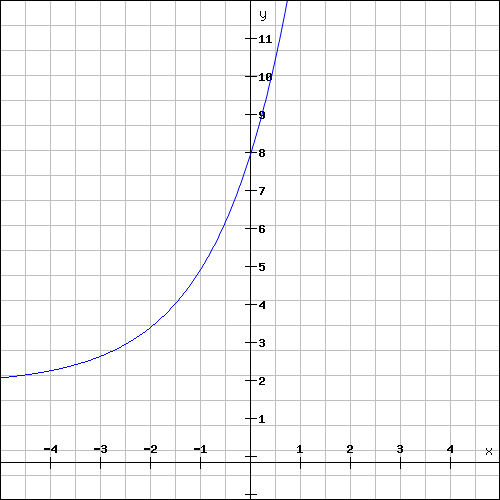| << Chapter < Page | Chapter >> Page > |
Therefore, if , then the range is , meaning that can be any real number less than . Equivalently, one could write that the range is .
For example, the domain of is . For the range,
Therefore the range is .
For functions of the form, , the intercepts with the - and -axis are calculated by setting for the -intercept and by setting for the -intercept.
The -intercept is calculated as follows:
For example, the -intercept of is given by setting to get:
The -intercepts are calculated by setting as follows:
Since (this is a requirement in the original definition) and a positive number raised to any power is always positive, the last equation above only has a real solution if either or (but not both). Additionally, must not be zero for the division to be valid. If these conditions are not satisfied, the graph of the function of the form does not have any -intercepts.
For example, the -intercept of is given by setting to get:
which has no real solution. Therefore, the graph of does not have a -intercept. You will notice that calculating for any value of will always give a positive number, meaning that will never be zero and so the graph will never intersect the -axis.
Functions of the form always have exactly one horizontal asymptote.
When examining the range of these functions, we saw that we always have either or for all input values of . Therefore the line is an asymptote.
For example, we saw earlier that the range of is because is always greater than 2. However, the value of can get extremely close to 2, even though it never reaches it. For example, if you calculate , the value is approximately 2.000006. Using larger negative values of will make even closer to 2: the value of is so close to 2 that the calculator is not precise enough to know the difference, and will (incorrectly) show you that it is equal to exactly 2.
From this we deduce that the line is an asymptote.
In order to sketch graphs of functions of the form, , we need to determine four characteristics:
For example, sketch the graph of . Mark the intercepts.
We have determined the domain to be and the range to be .
The -intercept is and there is no -intercept.

| A | B | C | |
| -2 | 7,25 | 6,25 | 2,5 |
| -1 | 3,5 | 2,5 | 1 |
| 0 | 2 | 1 | 0,4 |
| 1 | 1,4 | 0,4 | 0,16 |
| 2 | 1,16 | 0,16 | 0,064 |

Notification Switch
Would you like to follow the 'Siyavula textbooks: grade 11 maths' conversation and receive update notifications?